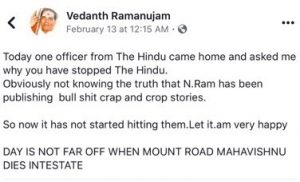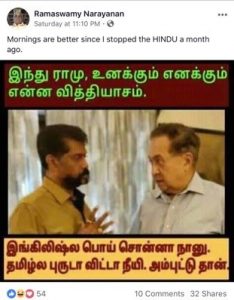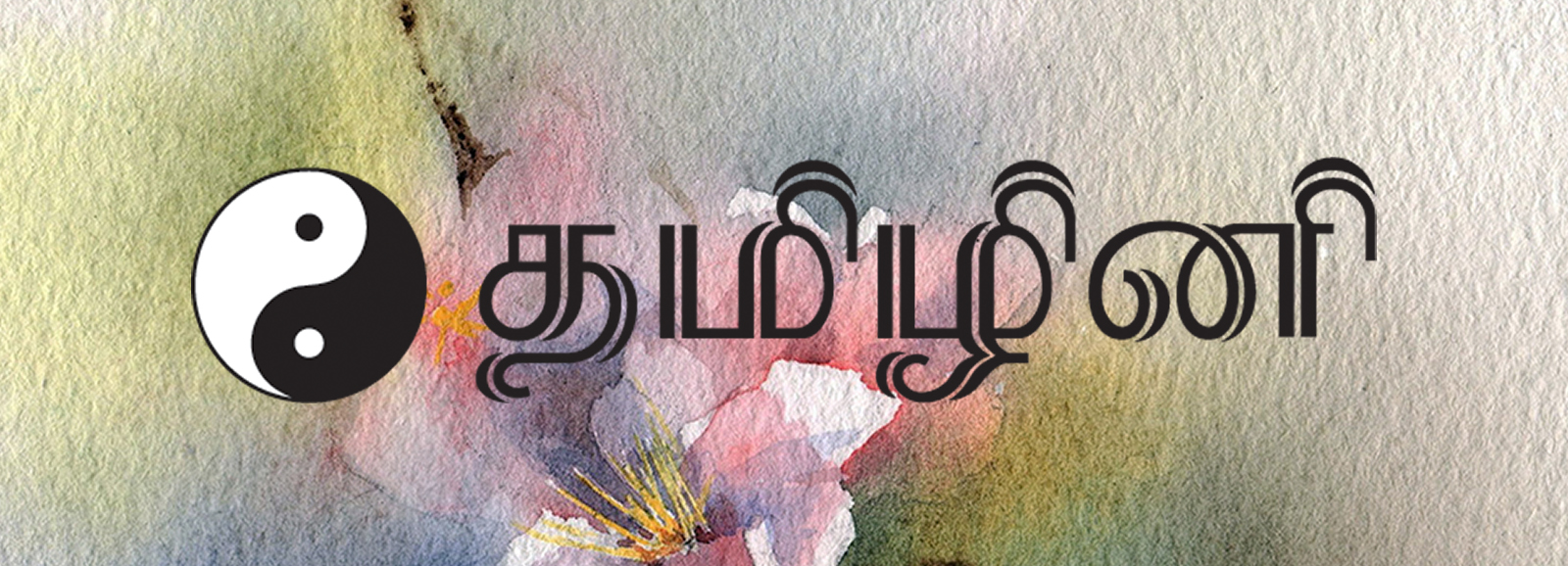If there is one field or industry or fraternity in India that has a crying need for diversity and showcases the perils of lack of diversity today, it is the Carnatic music field in South India. A panel discussion held to discuss whether there’s lack of diversity and related caste and gender issues itself became a flash-point for competing voices, one of angst and another of privilege.
Nrithya Pillai: A Lonely Presence Amongst the Privileged
‘Aneka’ a conference ‘convened and conceptualized’ by Dr. Srinidhi Chidambaram was held between Dec 26th ‐ 28, 2018. The conference included a panel discussion titled, ‘Caste, gender, privilege and their roles in the Bharatanatyam landscape’.
The panelists included Akhila Krishnamurthy, editor of Aalaap; Janaki Shrinivasan, editor of Sruti Magazine amongst other distinctions; Nrithya Pillai, dancer and artistic director of Rajaratnalaya; Tulsi Badrinath, author and disciple of Dhananjayans; and Dr. Srinidhi Chidambaram. The moderator was author and columnist V. Sriram, considered by many, a historian. He’s chiefly a treasure house of trivia and anecdotes.
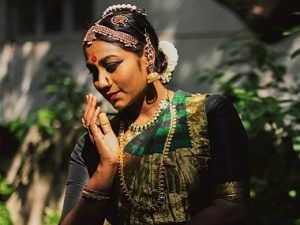
Nrithya Pillai
Srinidhi in her opening remarks said, “What makes a Bharatanatyam dancer succeed, among a plethora of equally talented artists. What is that X-factor? Are gender, caste and privilege significant contributors? In a sense we have to ask the question whether success is restricted to some people? Or are these disparities only a myth among people who do not want to…..who want some reason to say they’re not successful?”
Srinidhi, a Brahmin, could not have spoken with a more privileged voice with condescension. I’d not accuse her of being intentional, rather she’s probably ignorant of how to even conduct a discussion like this because topics like diversity and racial equality and how to talk about them academically are just budding in India. That also explains the lack furor over such insensitive opening remarks and why, instead, a vicious backlash ensued against Nrithya Pillai for her remarks.
The panel composition itself is curious in that Brahmin women and a man dominated it. Nrithya Pillai, as the discussion progressed, was more the odd person. A panel supposed to discuss gender issues could not find a single male dancer to be a part of the discussion.
Sriram directed a question relating to caste to Nrithya and prefaced it by characterizing her writings on caste are uncomfortable to the reader but essential, like how Jabali, a rishi in Ramayana, spoke daringly to Rama that he should not go on exile and discard his father’s diktat as the order of a senile man.
Nrithya spoke in measured and mellowed tone, contrasting with the tones of the others. It is possibly just her persona and less to do with any other differences. She spoke of how her grandfather doted on her and said “if you ask me if casteism exists in it’s raw form, I cannot say so”. She proceeded to add that she can perceive it nevertheless. She highlighted how she does not fit in, specifying her complexion and physique. She has been asked, she says, why she writes often about casteism. This is practically a few minutes of her speaking and she speaks only once or twice more of equal length in a video of 90 minutes.

Srinidhi, in what could be called a rebuttal, said that the issue was that Bharathanatyam, unlike carnatic music, drew lesser audiences and sabhas faced the unenviable task of providing performance opportunities for a few amongst many contenders. She portrayed it almost as if the demand for performances would be the panacea. Then her intrinsic voice of privilege poured forth unchecked. While confessing that she, for obvious reasons, has not experienced caste discrimination she adds, “hard work is very important”. Then very condescendingly proceeds to say that “if you have put in the work and you still don’t get the recognition then the X-factor, it is so difficult in a crowded field…”. Srinidhi, like another Brahmin musician said to Nrithya, could very well have said “don’t come looking for caste based reservation or quota”. That’s precisely what she was, pardon the pun, dancing around delicately.
Pivoting the discussion away from caste Sriram then queried Tulsi Badrinath about male dancers. He spoke of a visit to Kalakshetra and derisively referred to how Rukmini Arundale was worshiped as a ‘idol’ in everything that transpires in that institution. I wonder if Sriram thinks Thyagaraja Aradhana is idol worship too or is such derision reserved only for a woman.
Janaki in later remarks said that there’s no caste discrimination in teaching and that teachers don’t ask for caste. This is utter nonsense. In a society where just a name or even a word a student uses to denote ‘home’ can indicate caste and few other markers are readily available only idiots have to ask for caste of a student. I can speak of Hindu epics and philosophy for quite some length but no one will mistake me for a Brahmin after talking to me for 2 minutes. It’s really that simple. Janaki then asks Nrithya why she has internalized the notions of discrimination.
Nrithya in her reply traces how the devadasi community itself, and others, effaced the contributions of women and how the males, took the forefront, in order to make a livelihood, thereby having to cater to a Brahminical audience started providing different themes to suit their tastes. She then said how even Vazhuvoor Ramiah Pillai expresses his dismay at how much of what he did first was instead credited to Rukmini Devi ( Sruti magazine ). In fact many nattuvanars have voiced their disappointment as to how they have been denied credit and due acceptance. She is correct in speaking of how devadasi families themselves wanted their women to be dissociated from the art not wanting to be stigmatized. Balasaraswati’s family did not readily agree to her becoming a dancer, this despite she belonging to one of the most famous families of the tradition. Sriram then chimed in that his mother’s favorite retort on seeing attendees at a performance that did not fit the ‘usual profile’ that “new kind of attendees are seen”.
Leela Venkatraman’s Voice of Privilege:
Commenting on this panel discussion in ‘Narthaki.com’ Leela Venkatraman wrote, “I must admit that caste at least in Delhi circles I have known, has never played a part”. This is patently stupid. Delhi is NOT the representative sampling area for casteism in Bharathanatyam.
Leela then lights into Nrithya Pillai and that deserves a full quote:
“But in all this, one is sad to see Nrithya Pillai spewing anger and bitterness about people from the ‘traditional’ hierarchy being denied opportunities. Representing the Bharatanatyam tradition in all its essence was Bala Saraswati whose grandson Aniruddha, despite all that the family may rightly be bitter about, shows a maturity in trying to come to terms with changing times, working at finding his own place in the scheme of things. Yes, heredity does bestow on the artist, authenticity. But quoting it as an entitlement for performance space does not always work. Expertise in how that legacy is expressed in terms of a performer today is what counts. By the same token, Birju Maharaj’s sons can demand a lion’s share in the performance scene. But it is not so. In the meanwhile, such corrosive bitterness could stand in the way of artistic growth of the person concerned.
There are others, with no clout or backing of any type political or otherwise, but who are excellent dancers, relegated for some unknown reason to the back-burner of the selection process. While one has known feelings of disappointment, such caustic feelings have never been expressed. Nrithya Pillai would be well advised to develop a more healthy attitude which will not stunt her own growth as an artist.”
The sheer breadth of malice is unbelievable. While Sriram could freely chastise idol worship at Kalakshetra and call Indian society racist it is Nrithya, her extreme politeness notwithstanding, who is called out for ‘spewing anger and bitterness’. It is sheer chutzpah for a Brahmin writer to commend a non‐Brahmin performer for having found “his own place in the scheme of things”. After condescendingly saying that hereditary dancers could’ve authenticity – that itself is a troublesome acceptance – Leela imputes that Nrithya was somehow citing that as an ‘entitlement’. Then Leela proceeds to advise Nrithya that such ‘corrosive bitterness’ could stand in the way of her progress. When Leela says, “such caustic feelings have never been expressed” she’s essentially saying, “shut up woman”. Not contended with already having advised Nrithya the writer makes a not so subtle threat that if she does not ‘develop a more healthy attitude’ it’d ‘stunt her growth’. Having doubted Nrithya’s intelligence in understanding a statement once perhaps Leela should’ve also helpfully detailed what a healthy attitude is. Leela would make any white supremacist group proud. Ah, but then, white supremacists have to learn from her.
Case in point is how Swarnamalya readily finds acceptance in academic circles whereas Nrithya is rarely seen in those circles. Swarnamalya’s recent lec‐dem on Bharathi’s songs was cringe worthy for her choreography that reminded me of T. Rajender’s filming of songs that were practically schoolyard mimes. Added to that was her near total lack of understanding of Bharathi.
Coming on the heels of this controversy was the back and forth between Dhananjayan and Nrithya in the columns of Hindu over renaming extant repertoire of Bharatanatyam. Nrithya, while conceding that many names are already Sanskrit in origin, defended those that are not and called into sharp question the desire to, selectively, Sanskritize Bharatantyam repertoire.
Talking of lack of diversity even amongst panelists why is it that when we talk of male Bharatanatyam dancers only Dhananjayan is often mentioned? Why is there never a mention or even seeking out of an artiste like Kali Veerapadiran, a Dalit who learned Bharatanatyam and unlike most Bharatanatyam dancers he has also specialized in folk dances. Aparna Karthikeyan has done a nice profile of this dancer who’s battling multiple barriers of caste and gender.

Kali Veerapadiran
If one has to understand the network of privilege one should look at how the conference was featured in the leading English newspaper, The Hindu. Generally newspapers are supposed to publish a news or event after it had happened provided it had some significance. Here, The Hindu published news ‘item’, a genre unique to Indian journalism; a week ahead of the event and literally just outlined the agenda day by day. This is also usually called a ‘press release’. Someone or some organization would send a note to a compliant news outlet about an event or whatever they want to publicize and the press outlet, literally a lap dog, will duly publish it.
Anyone who follows the happenings of Carnatic music and Bharatanatyam in Tamil Nadu knows of the nexus between The Hindu, the Music Academy and this art form. They form a triad of a zealously casteist and protective privilege. Social media gives a window into casteism and bigotry amidst carnatic musicians.
Sarvam Thaala Maiyyam to Pulwama: When Casteism and Bigotry Ran Amuck:
‘Sarvam Thaala Maiyyam’, a pedestrian and crappy movie about a boy from lower caste of mridangam makers desiring to become a mridangam player against the odds of casteism and class differences, became an occasion for vitriol to pour forth in a post by Palghat Ramprasad.
Palghat Ramprasad has every right to trash any movie or anything and that is not the issue. He could even feel irked by how Brahmin casteism was portrayed. But then he decided to go for the jugular. Indignant over casting aspersions about barriers to learn a musical instrument he asks, “ is it easy for a person with a kudumi, pattai, rudhraaksham and poonal to be accepted to play thara thappattai without any resistance?”. ‘Thaarai Thappattai’ is played, exclusively, by Dalits and the exclusivity is not a privilege but it what they were condemned to play. Made of animal skin and played at funerals only Dalits were ‘condemned’ to play that.

A Still from the movie ‘Sarvam Thaala Mayam’
Guessing the blowback his insensitive remark would draw Ramprasad added, “Won’t be surprised if pseudo-liberals jump on this by asking will any upper caste take to it? Because that’s the level of depth they can get into”. No, Mr. Ramprasad anyone who jumps and points out your callous insensitivity is not a pseudo‐liberal but a human being with a conscience.
Not content with being insensitive Ramprasad piles it on when he bemoans, “We are in a time where if a person from the so called socially higher caste uses a caste affiliation term on the so-called marginalized caste, the former can be behind bars without trial”.
What Ramprasad is referring here is to the ‘Prevention of Atrocities Act’, which, amongst other caste related offences, makes calling a Dalit by caste name a non-‐ bailable offence. In his blind rage Ramprasad does not distinguish between holding a person without possibility of bail and sentencing without a trial. The latter is NOT what the law provides. This law, in reality, is rarely enforced and is practically effete. Any human rights advocate will easily establish how Dalits can rarely get a case registered in a police station when the offenses are far more violent than just name‐calling.
If a White man bemoaned that he cannot use the N-word to refer to African-Americans when talking about racial discrimination to rebut that discrimination even exists then such a White man would be called, unhesitatingly, by anyone with a conscience as a racist. That is precisely the question Ramprasad raised.
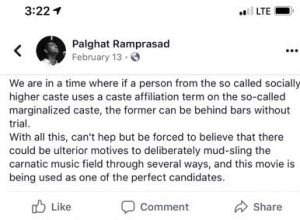
Neyveli Santhanagopalan took it a step further by sharing an online petition (not sure, if he created it) titled, “Raise against hate towards Brahmins” (note, I’ve reproduced the title and yes it has a mistake). The petition lamented that Brahmins are portrayed in a ‘negative character’ due to the past actions of a few, then imputed the hatred to “foreign missionaries” and finally called for a law titled “Brahmins Atrocities Act (BAA)” to punish anyone making fun of Brahmins. The irony is the title suggested. Read it again.
Commenting on the post by Ramprasad another artiste, Mathangi Kailasanath wrote, “Caste discrimination exists more in the so called lower caste than in the so called upper caste. People have always thought Brahmins as easy targets. Which I don’t think we should be anymore.” In what world do these artists live? Where do they learn their history?
The really breathtaking comment was by one Krishnaswamy Swamy, reproduced here. These are not occasional outbursts. Visit the pages of these artists and you’ll know that this is exactly their worldview. Note the ‘likes’ such comments garner. What is worse no one, not a single soul, castigated the commentator.

The terror attack at Pulwama brought out interesting posts. As the Prime Minister and the nation thirsted for action and expectations were high for a retaliatory attack a rasika had a pressing doubt. He asked if there’s any raga that would increase the ‘Kshatra Bhava’, a warrior temper. To that question the singing duo Ranjani-Gayathri replied that the thundering march of the Indian army is itself music.
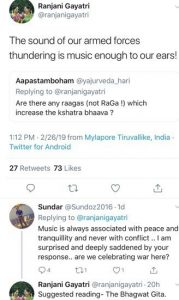
Tamil literature and culture have a long and hoary heritage of music that includes a genre for war literature and instruments meant for war music. Such a vibrant culture that throbbed with life became flaccid when it was imprisoned within the walls of devotion thanks to who took over the music. To make it worse the practitioners have little knowledge of a rich heritage that they’ve trampled over.
Replying to one who questioned about the war mongering the duo replied, “Read Bhagwat Gita”. Many critics have pointed to Gita’s famous exhortation “therefore thou shalt kill” as encouraging blood lust. Yet Gandhi found in it a message of peace for the modern era. Subramanian Swamy and the duo, interestingly, echo what their arch nemesis K. Veeramani said of Gita. Veeramani would tell them, “thanks. Q.E.D”.
The singing duo is quite vocal about their political choices. Recently ‘The Hindu’ irritated quite a number of Carnatic musicians when N. Ram published a detailed expose on a defense deal by the Modi government. One can disagree with Ram’s investigation or journalism but Ranjani‐Gayathri decided to up the ante and wondered in a tweet whether ‘The Hindu’ should be called ‘The Islam’. Palghat Ramprasad who took pride in unsubscribing to the newspaper nevertheless gleefully shares reviews that appear in The Hindu which celebrate him for doing justice to his lineage.
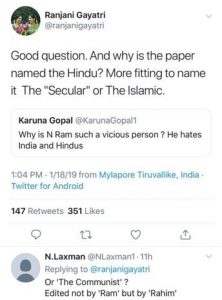
The worst possible post by Ranjani-‐Gayatri was possibly the one below on Facebook. Let’s ignore for a moment that they’re maligning Jawaharlal Nehru. Even Gandhi is not spared. A Hindutva meme shared by a notorious site, alleges that Gandhi and Nehru were “treated as VIPs by the British government. Responsible for partition. Now called great Chacha and Bapu”.
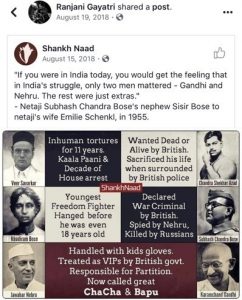
Having been political orphans for decades in Tamil Nadu thanks to the shrill and even Nazi like anti‐Brahmanism of Dravidian politics many, not all, Tamil Brahmins have jumped to the Modi bandwagon. Beyond finding a political home they do see ideological kinship. In caste driven politics if some castes can choose DMK or ADMK I’ll not begrudge the Brahmins their freedom. However, let’s not shy from identifying the caste affiliations. This political alignment is in sharp relief in Carnatic music due to the plurality of one caste.
Bigotry against minority communities is par for the course in this political climate amongst the Tamil Brahmin community. Ram Prasad has alleged that Tamil Nadu Chief Minister J. Jayalalithaa’s shocking arrest of the Kanchi pontiff was the result of a payoff by the Vatican. This is a man who boasts of being a data person with degrees from reputed universities in US.
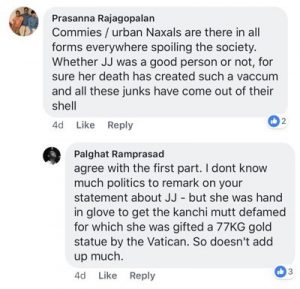
T.M. Krishna and Christian Appropriation Controversy:
Nobody riles up the Carnatic music crowd like T.M. Krishna does. When it comes to Krishna the community just lets loose vitriol and sheer hatred. When Krishna said he’d sing songs about Allah and Jesus each month, the Carnatic music fraternity just went into collective insanity. One of his performances at a temple in US was cancelled and a rasika promptly called for ostracizing Krishna. Oh what a poisonous demand and quite unsurprising if one knew the long and dark chapters of Indian history.
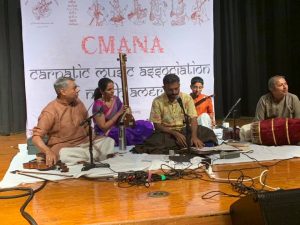
TM Krishna performing in a Lungi
When I posted a picture of Krishna performing in a lungi , a torrent of abuse followed. Just a change in attire provoked the fury. Comments included jibes at Muslims. Pious protestations that it is Krishna’s politicization of music that they hate are usually trotted out. No, his detractors don’t hate politicizing art what they hate is the type of politics that Krishna espouses. Krishna’s criticisms are inconvenient truths. Those criticisms are nothing new except that it is now openly coming from deep within the fraternity and from some one who could not be brushed aside.
Those, like the artiste below, who think that Carnatic music is one of their “last bastions” are naturally irked by Krishna.
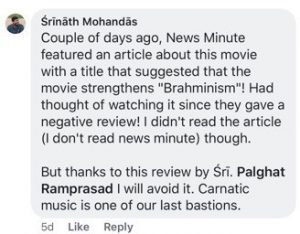
Last fall the Carnatic music fraternity really exploded into near total furor charging Christians as trying to appropriate ‘their’ music. Baseless charges and accusations based on facts torn out of context flew thick and fast. This is not the place to get into it in full detail.
Carnatic music and its association with Tamil Christians go back to the days of Vedanayakam Sastriar (1774-1864), a contemporary of Thyagraja (1767-1847). A recent conference on music by a Hindutva group chided Vedanayakam for composing verses deriding Hinduism. This is rich with hypocrisy coming from Hindus. One has to only plumb the Vaishnavaite and Saivaite literature for the choice abuses they hurled at each other and at Jains and Buddhists. When Jabali, the rishi cited by Sriram, instructs Ram to ignore the edict of his father Ram scolds him and says, “we rank the Buddhist with the thief”.
If Thyagraraja’s misogyny should be understood contextually then so should Sastriar, an evangelical poet, should be understood. Raja Serfoji tried compelling Sastriar to compose a song about Hindu gods and Sastriar refused. How is this any different from anything Thyagaraja would’ve done?
Samuel Vedanayagam Pillai (1826‐1889), also known as Mayavaram Vedanayagam Pillai, author of what is called Tamil’s first novel, had composed Christian hymns. Later in life he composed ‘Songs on the equality of all faiths’. He collaborated extensively with Gopalakrishna Bharathi and earned the admiration of Ramalinga Adigal. Pillai, unlike Thyagaraja, composed a lot of hymns in Tamil and was celebrated by the Tamil music movement in later years. Histories of both, Sastriar and Pillai, demonstrate that Carnatic music did not begin just with Thyagraraja. It is this story telling that Nrithya Pillai, amongst others, continually draws attention to. And it is for that reason that she’s being silenced by the voices of privilege.
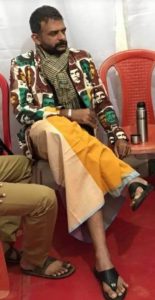
A towering figure of music that was a Christian too was Abraham Pandithar. Much before there was a Music Academy it was Abraham Pandithar who conducted music conferences, on his own dime, wrote a treatise on music, participated in music conference conducted by Bhatkande. Pandithar’s treatise on music contains manufactured history of roots of Carnatic music. Such myth making was pretty common in that era and any modern reader can easily rubbish them but only a bigot would rubbish Pandithar’s music or his contributions to Carnatic music.
There’s a lot of bull crap spoken about use of words by Christians that could be called Hindu in origin. Like, Vedanayagam Sastriar’s very name. This is laughable. Words don’t belong to religions or castes. But then that’s what some have always thought so. Take any English article on Carnatic music or Hindu philosophy then you’d see words that literally originated in the Church or Christian theology. One cannot write in English, especially about religion or philosophy, without using some liturgical terms that the Church created. Part of this misunderstanding is because the Brahmins are completely unaccustomed to translating their own sacred texts into vernacular languages and don’t understand the politics of translations. The very idea of translating God’s words into vernacular is a signal contribution of the Reformation and everything that a Brahmin holds dear is in opposition to that.
This lack of understanding of different cultures and different histories is absolutely tied to the lack of diversity amongst the practitioners. Too often the question whether there’s overt discrimination is asked. Discrimination is at its most venomous when it is NOT overt but subliminal. How does that happen?
In-Group-Preferences, Caste Marks as Costume and Plight of Instrument Makers:
Sociologist Kwame Anthony Appiah, discussing how a Chinese restaurant that provides lower priced options, without asking, to Chinese diners and to others only after they ask, provided they knew that such a lower priced menu exists, says that is a sign of “in-group preference and not out‐group hostility”. This is probably the most prevalent sort in Carnatic music circles. It is not uncommon to find Brahmins, like any others, preferring their own cohort and accepting them readily for any opportunity while they may not have an active hostility towards others.
In that act of in‐group-preference a key role played are exterior markers. Many male performers in Carnatic music today exemplify this. They go about their daily lives like any one else in pant and shirt or any attire that’d ,it an occasion and importantly without the sacred ash on their forehead or similar marks. But, they’d never ascend a music stage without liberally smearing it and ensuring that it is visible. This is what T.M. Krishna referred to as ‘’pattern recognition” in his remarks about M.S. during the launch of T.J.S. George’s book last year.
O.S. Arun was stupid to adorn a cross just because he was singing a Christian hymnal but I guess he thought that he was just putting on a costume like the rest do. As stupid as it was it is not too different from what the others do to connect with the audience. Incidentally Shankar Mahadevan donned a cap when he sang a Sikh song with Aruna Sairam. It is the same Shankar Mahadevan who, as part of his online tutorial to teach music, created a book titled, “Online Music book”. He referred to it as ‘OM book’. Oh lord.
It is not without reason that Ram Prasad uses ‘Palghat’ as a prefix to his name in his role as Carnatic musician despite the fact that he has little to do with Palghat unlike his illustrious grand father. The idea is to evoke a welcoming attitude in the minds of reviewers and attendees even before he sings the first note. That is why the reviewer from Hindu joyously spoke of his lineage. Ram Prasad may very well be a great singer and he has every right to capitalize on his family’s fame but let’s not turn a blind eye to the fact that he is indeed milking his advantage.
One of the comments on ‘Sarvam Thaala Maiyyam’ mocked the supposed discrimination against instrument makers from practicing the art and asked “would making cricket balls be a qualification for becoming a cricketer”. Oh these guys really have chutzpah.
The dichotomy of who makes the instruments and who gets to be performers is stunning in Carnatic music. Brahmins are completely absent from making instruments and the castes that make the instruments are, even if present, are only marginally counted as performers. While the penury of the instrument makers cannot be entirely ascribed to the Brahmin community and we have to concede larger economic forces at work we cannot, still, deny caste is at work in this dichotomy.
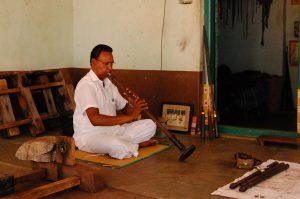
Aparna Karthikeyan, noted researcher of rural lives, has written sensitive columns about the makers of Nadaswaram and Veena languishing in poverty despite practicing a manufacturing art that requires nuanced knowledge. Even a cricket ball manufacturer needs knowledge of the game and the nuances. Only casteist hubris can make one hurl such moronic remarks about a people without whom these silk jibbas and silk sarees will have nothing to brag about.
Founder of music organization Parivadini and ardent supporter of Nadaswaram artists, Lalitaram Ramachandran, recorded how even today Nadaswaram artists are treated shabbily by the Music Academy.
The most fabled family of mridangam makers was Dalit Christian. Brahmins have downplayed how cows are killed to make mridangams. An article in ‘Outlook’ called out the musicians for being squeamish on this topic. “Thiruvarur’s Rajamanikkam” told Outlook, “Have these people ever been to a slaughterhouse to see what we do? We examine cows and choose the healthy ones that have good, lustrous, soft skin. The cow should have given birth at least a couple of times but shouldn’t be too old. We pay Rs 1,500 for the hide of one such cow.”
Is there hope?
The Voices of Moderation:
There is, amidst the abyss of casteism, hope. A glimmer of hope is there. While the voices of bigotry and casteism, make no mistake, are a clear vocal majority there are also voices of dissent and protest and magnanimity from within the Brahmin community.
If T.M. Krishna is raising a very loud banner of revolt there’s Chitravina Ravikiran who’s attempting to take Carnatic music to school children and consistently harps on anyone learning. Lalitaram Ramachandran and Aparna Karthikeyan add their voices in their own ways. Then there are others who, rather silently, expand boundaries and tamp down on bigotry in their circles.
I’m keenly aware of the virulent strain of anti-Brahminism that plagues Tamil Nadu. Too often other castes, notably the non-Brahmin upper castes, have happily escaped scrutiny by cheerfully adopting terms like ‘Brahminism’ as catch all for casteism but in reality meant to convey the impression that only Brahmins indulge in it. I do not for a moment think that every Brahmin fits a stereotype or much less have to answer for the acts of his fellow community.
Let’s join hands with people of good will. Combat bigotry anywhere you see it. Call out bigotry every time you see it.
Blogs on anti-Brahminism
I’m including this list only for those who may come to know me for the first time through this article.
- Badri Seshadri’s Brahminical Angst Meets Neo‐Nazi Lynching and Stereotyping (pro and anti) written when Badri Sheshadri, publisher and entrepreneur, wrote an oped asking for political space for Brahmins to speak and the furor that ensued – http://contrarianworld.blogspot.com/2014/12/badri-seshadris-brahminical-angst-meets.html
- http://contrarianworld.blogspot.com/2011/03/anti-brahminism-and-racism-amongst.html
- Here’s a take on E.V.Ramasamy and anti‐Brahmanism – http://contrarianworld.blogspot.com/2013/05/evr-to-kaduvetti-guru-saga-of-hatred.html
References
- Nrithya Pillai and Panel Discussion – https://www.youtube.com/watch?v=KoXATttprCE&feature=youtu.be&,bclid=IwAR1,jVYz7My5Lg_yOa6H9JkCxtXd%20F4UCYaZhVvIo6Ks5xLESsQhc0QhQv1
- https://www.thenewsminute.com/article/calling-out-casteism-dance-world-has-made-me-outsider-nrithya-pillai-95871
- Leela Venkatraman’s backlash –http://www.narthaki.com/info/taalam/taalam82.html
- Protestant Origins in India: Tamil Evangelical Christians, 1706-1835 by D. Dennis Hodson. Good material on Vedanayagam Sastriyar.
- Colonizing the realm of words: The transformation of Tamil Literature in Nineteenth Century South India – Sascha Ebeling. Good material on Vedanayagam Pillai.
- https://en.wikipedia.org/wiki/Samuel_Vedanayagam_Pillai
- https://ruralindiaonline.org/articles/narasingapettais-nadaswaram-makers
- https://www.thehindu.com/features/magazine/the-veena-makers-of-thanjavur/article7407233.ece
- https://www.thehindu.com/features/magazine/narasingapettais-nadaswaram-makers/article7088894.ece
- https://www.outlookindia.com/magazine/story/thyagarajas-cow/221354
- Aparna Karthikeyan on Kali Veerapadran – https://ruralindiaonline.org/articles/kali-the-dancer-and-his-dreams
- Unsubscribing The Hindu as badge of Honor.
